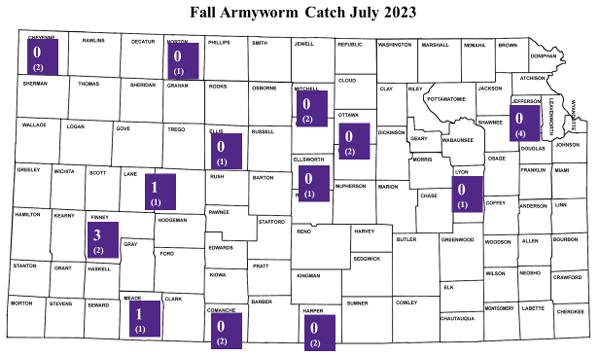Fall armyworm, Spodoptera frugiperda, can damage several important Kansas crops as well as pasture, turf, and home landscaping. This insect does not overwinter in Kansas. Rather, it is native to the tropical regions of the western hemisphere and is active year-round along the gulf coast and southern Florida, migrating in from these locations each year. Two full generations are possible in Kansas with defoliation and grain damage being the biggest concerns.
The first detected fall armyworm for the season was on June 16 in the Central Kansas district. Moths were also captured in southwest Kansas in the final week of June. Overall, the numbers were very low (Figure 1). The total number of moths caught so far in July has been low as well and restricted to the southwest (Figure 2).

Figure 1. Fall armyworm moth captures in June. The number in parentheses indicates the total number of traps in the county. Map by Anthony Zukoff, K-State Research and Extension.

Figure 2. Fall armyworm moth captures in July. The number in parentheses indicates the total number of traps in the county. Map by Anthony Zukoff, K-State Research and Extension.
The number of moths entering Kansas will likely increase through July and at-risk crops should be scouted regularly for the remainder of the growing season. Caterpillars increase in size at an exponential rate and a majority of feeding occurs during the later stage of development. It is critical to scout thoroughly and treat if needed before the caterpillars are over ½ inch long. Larger caterpillars are harder to control and do the most damage. Keep in mind that it is the second generation of fall armyworm that poses the greatest risk, especially for heading sorghum. The first generation is usually small, and crops are in vegetative stages. Caterpillar feeding will make plants look bad, but yield is not at risk with the first generation. Additionally, use caution when making control decisions in alfalfa as flaring aphids is possible. Recommended thresholds can be found below.
Fall Armyworm Thresholds
Alfalfa
- 1-2 caterpillars per square foot can destroy seedling alfalfa
- 10-15 per square foot can destroy 12-inch tall plants.
Corn
- damage to whorl stage in early summer
- treatment may be needed if 75% of plants are damaged
- Bt corn may prevent ear damage.
Sorghum
- damage to whorl stage in early summer
- treatment may be needed if 75% of plants are damaged
- 1-2 larvae/head during flowering to soft dough reduces yield 5-10%
Wheat
- Larval “window-paning” in early planted wheat can be a concern
- If 25-30% of plants show damage, examine the field frequently
- Treat at 2-3 active larvae/ft.
Anthony Zukoff, Extension Entomology Associate – Garden City
azukoff@ksu.edu
Tags: insects armyworms fall armyworms